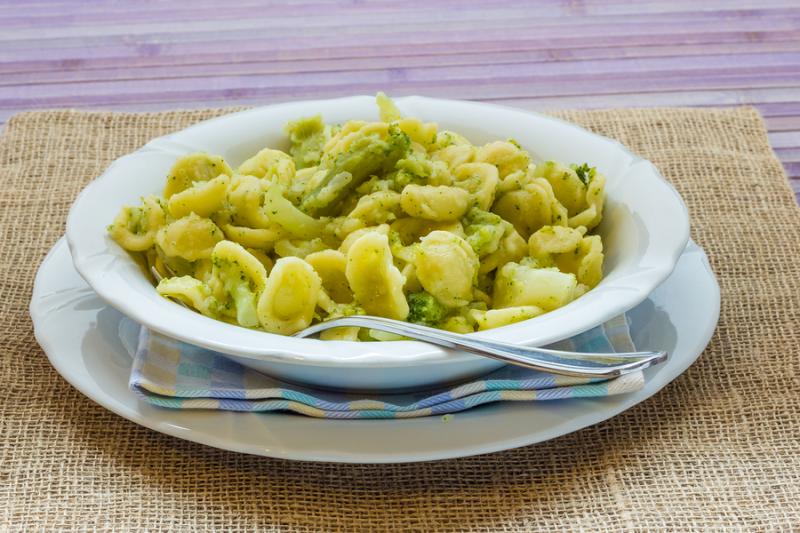Orecchiette with Turnip Tops: Apulia’s Most Famous Dish
ITA:

Use player to listen to Italian version
With their unmistakable shape similar to a small shell, orecchiette are Apulia’s most famous pasta, beloved all over Italy, whether seasoned with a simple tomato sauce or with tasty turnip tops, the most famous sauce to go with them, typical of the local cuisine.
Orecchiette seem to date back to the period between the 12th and 13th centuries, and hail from the Bari area. Not all historians agree on the Pugliese origin of orecchiette, believing that they actually hail from Provence, where a similar format of pasta was already produced in the Middle Ages; they then would have been exported to Puglia by the Angevin dynasty, who conquered the area in the 13th century. A written recipe from the 16th century is kept in the archives of the Church of San Nicola di Bari.
They’re made with durum wheat semolina, water and salt, and their shell shape makes them ideal for collecting a thick sauce.
In the traditional preparation of the dough, they’re worked rigorously by hand and modeled with three fingers, while dragged on the pastry board; the result should be a smooth interior and a rough outer surface.
Orecchiette with turnip tops are perfect if all the ingredients used for the recipe are fresh and balanced between them. The right amount of salted anchovy should blend with the simplicity of the dough and the bitter vegetables. Everything should be flavored with good extra virgin olive oil and fresh chili flakes.
Preparation: Brown the garlic in olive oil, then add the anchovy fillets. Meanwhile, wash well the turnip tops and remove the excess parts. Boil, then sautée in a pan with garlic. Bring salted water to a boil and toss in the pasta. When the pasta is cooked, using a ladle, add the orecchiette to the pan. Finally, add fresh chili pepper, black pepper and a little extra virgin olive oil. Serve hot, and grate the typical Apulian cheese, cacioricotta, on top.
Con la loro inconfondibile forma simile a una conchiglia, le orecchiette sono la pasta più famosa della Puglia, amata in tutta Italia, sia condita con una semplice salsa al pomodoro che con le gustose cime di rapa, il condimento più famoso per accompagnarle, tipico della cucina locale.
Le orecchiette sembrano risalire al periodo tra il XII° e il XIII° secolo e provengono dalla zona di Bari. Non tutti gli storici concordano sull'origine pugliese delle orecchiette, ritenendo che provengano invece dalla Provenza, dove un simile formato di pasta era già prodotto nel Medioevo; sarebbero poi state esportate in Puglia dalla dinastia angioina, che conquistò la regione nel 13° secolo. Una ricetta scritta del XVI° secolo è conservata negli archivi della Chiesa di San Nicola di Bari.
L’impasto è fatto con semola di grano duro, acqua e sale, e la loro forma a conchiglia le rende ideali per raccogliere sughi ricchi.
Nella preparazione tradizionale dell'impasto, sono rigorosamente lavorate a mano e modellate con tre dita, mentre vengono trascinate sulla spianatoia; il risultato è un interno liscio e una superficie esterna rugosa.
Le orecchiette con le cime di rapa sono perfette se tutti gli ingredienti utilizzati per la ricetta sono freschi ed equilibrati tra loro. La giusta quantità di acciuga salata dovrebbe amalgamarsi con la semplicità dell'impasto e le verdure amarognole. Tutto dovrebbe essere aromatizzato con un buon olio extra vergine di oliva e un po’ di peperoncino fresco.
Preparazione: rosolare l'aglio in olio d'oliva, quindi aggiungere i filetti di acciuga. Nel frattempo, lavare bene le cime di rapa e rimuovere le parti in eccesso. Bollire, quindi soffriggere in una padella con aglio. Portare a ebollizione l'acqua salata e aggiungere la pasta. Quando la pasta è cotta, usando un mestolo, aggiungere le orecchiette nella padella con le cime di rapa. Aggiungere infine il peperoncino fresco, il pepe nero e un po' di olio extra vergine di oliva. Servire molto caldo, grattugiando il tipico formaggio pugliese, la cacioricotta.











